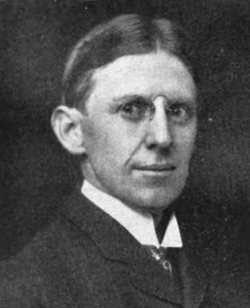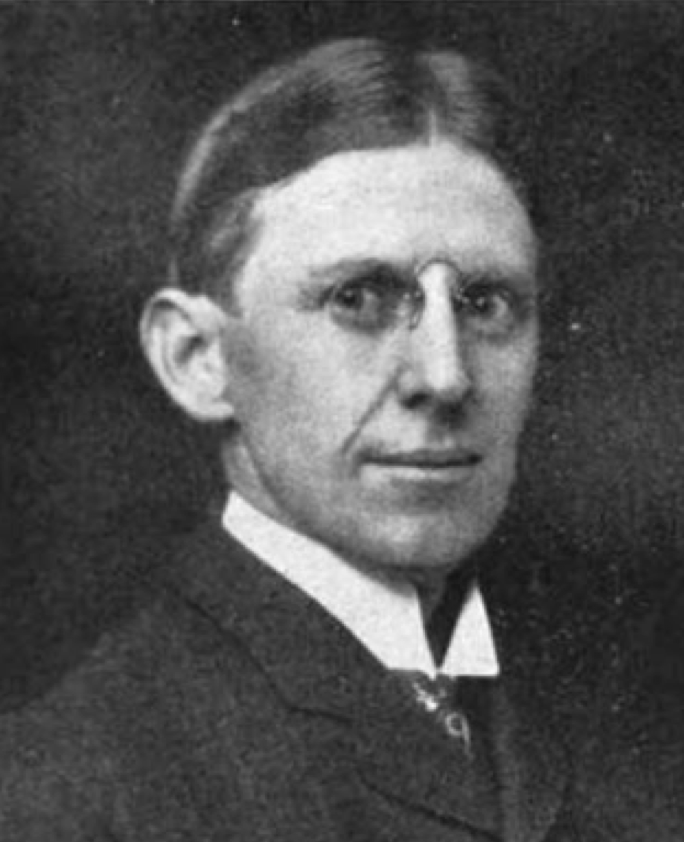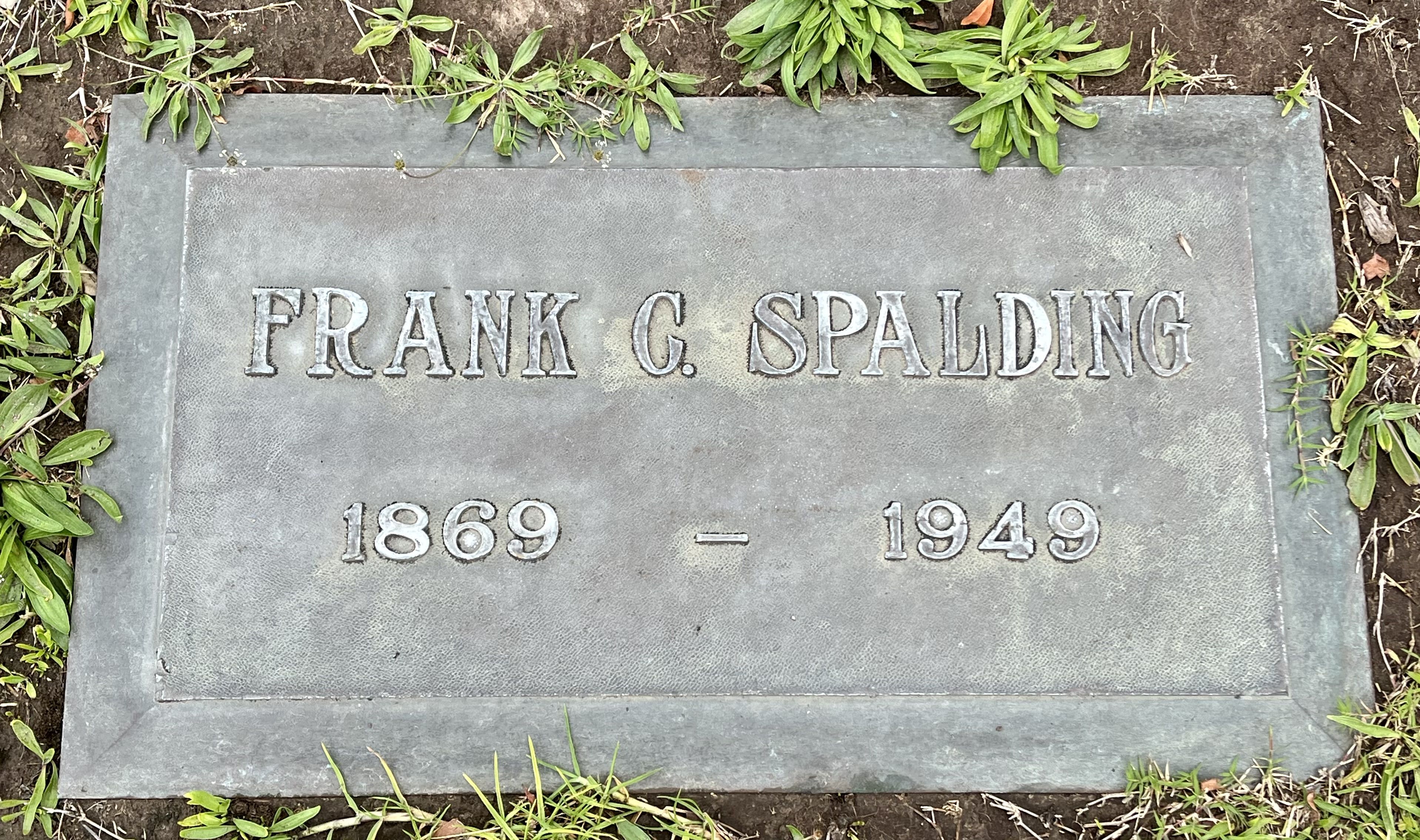Frank Carr (F.C.) Spalding was a new arrival in San Diego in 1908 who saw San Diego's booming real estate market as a financial opportunity, and for whom Spalding Place is named.
The Spalding family was established in real estate speculation and development by the time of Southern California's Great Boom in the mid-1880s. F.C. Spalding's father, Professor J.F. Spalding, had moved to Kansas City, Missouri, in 1865 and founded Spalding's Commercial College, which was one of the first schools in Kansas City. The college was very successful, and J.F. also expanded into local real estate, forming the J.F. Spalding Building Company. While J.F. operated the college in Kansas City, his brother W.A. Spalding moved to Los Angeles in 1874 to join the staff of the Los Angeles Daily Herald, embarking on a long and illustrious career in journalism and citrus agriculture in California. Their parents and sisters also moved to Los Angeles County in the late 19th century. It was likely W.A.'s influence that led his family in Kansas City to eventually immigrate to Southern California. By 1897, several of the Spaldings formed the Spalding-Powell real estate development company to develop a portion of Azusa in Los Angeles County.
F.C. Spalding was born in Kansas City on November 2, 1869. He was educated in the ward schools and the central high school, and then attended the University of Michigan. He made a trip to Los Angeles circa 1887, at the height of the Great Boom. Although his parents, uncles, and aunts, and even his grandfather, eventually lived in Los Angeles County and were involved in real estate development in the 1880s, F.C. remained in Kansas City working and teaching at Spalding's Commercial College as a manager and assistant superintendent, and then switched to a career in banking (Creel and Slavens 1902). He married Clara Louise Salisbury in 1895. His first trip back to Los Angeles was in 1904, during which "[h]e was amazed at the wonderful growth of the city, and the beauties also, and hopes some day [sic] to bring his family to California to live"(Los Angeles Times 1904). In Kansas City, Spalding became the secretary of the Surety Trust Company, later the Southwestern Trust Company. In 1908, he sold his interest in the company and moved to San Diego, where he became involved in speculative building and real estate sales.
During the prosperous era of the 1910s and 1920s in San Diego, F.C. Spalding became a prominent figure in San Diego, serving at times as the president of the Chamber of Commerce, secretary of San Diego Realty Board, the first secretary of the Panama-California Exposition commission, president of the Fellows Boat Works and the Greenwood Cemetery Association, treasurer of the Young Men's Christian Association and the San Diego Zoological Society, and even the commodore of the San Diego Yacht Club (Black 1913). In banking, Spalding became the vice president and trust officer of the Southern Trust and Commerce Bank (San Diego Union 1949). In 1915, Spalding took over controlling interest of the U.S. National Bank with investments from his family in Los Angeles, and served as president of the bank until the late 1920s. He died in San Diego in 1949 (San Diego Union 1949).
_________________________________
see:
https://www.sandiego.gov/sites/default/files/dsdhrb_agenda_20170508.pdf
Frank Carr (F.C.) Spalding was a new arrival in San Diego in 1908 who saw San Diego's booming real estate market as a financial opportunity, and for whom Spalding Place is named.
The Spalding family was established in real estate speculation and development by the time of Southern California's Great Boom in the mid-1880s. F.C. Spalding's father, Professor J.F. Spalding, had moved to Kansas City, Missouri, in 1865 and founded Spalding's Commercial College, which was one of the first schools in Kansas City. The college was very successful, and J.F. also expanded into local real estate, forming the J.F. Spalding Building Company. While J.F. operated the college in Kansas City, his brother W.A. Spalding moved to Los Angeles in 1874 to join the staff of the Los Angeles Daily Herald, embarking on a long and illustrious career in journalism and citrus agriculture in California. Their parents and sisters also moved to Los Angeles County in the late 19th century. It was likely W.A.'s influence that led his family in Kansas City to eventually immigrate to Southern California. By 1897, several of the Spaldings formed the Spalding-Powell real estate development company to develop a portion of Azusa in Los Angeles County.
F.C. Spalding was born in Kansas City on November 2, 1869. He was educated in the ward schools and the central high school, and then attended the University of Michigan. He made a trip to Los Angeles circa 1887, at the height of the Great Boom. Although his parents, uncles, and aunts, and even his grandfather, eventually lived in Los Angeles County and were involved in real estate development in the 1880s, F.C. remained in Kansas City working and teaching at Spalding's Commercial College as a manager and assistant superintendent, and then switched to a career in banking (Creel and Slavens 1902). He married Clara Louise Salisbury in 1895. His first trip back to Los Angeles was in 1904, during which "[h]e was amazed at the wonderful growth of the city, and the beauties also, and hopes some day [sic] to bring his family to California to live"(Los Angeles Times 1904). In Kansas City, Spalding became the secretary of the Surety Trust Company, later the Southwestern Trust Company. In 1908, he sold his interest in the company and moved to San Diego, where he became involved in speculative building and real estate sales.
During the prosperous era of the 1910s and 1920s in San Diego, F.C. Spalding became a prominent figure in San Diego, serving at times as the president of the Chamber of Commerce, secretary of San Diego Realty Board, the first secretary of the Panama-California Exposition commission, president of the Fellows Boat Works and the Greenwood Cemetery Association, treasurer of the Young Men's Christian Association and the San Diego Zoological Society, and even the commodore of the San Diego Yacht Club (Black 1913). In banking, Spalding became the vice president and trust officer of the Southern Trust and Commerce Bank (San Diego Union 1949). In 1915, Spalding took over controlling interest of the U.S. National Bank with investments from his family in Los Angeles, and served as president of the bank until the late 1920s. He died in San Diego in 1949 (San Diego Union 1949).
_________________________________
see:
https://www.sandiego.gov/sites/default/files/dsdhrb_agenda_20170508.pdf
Family Members
Sponsored by Ancestry
Advertisement
Explore more
Sponsored by Ancestry
Advertisement








